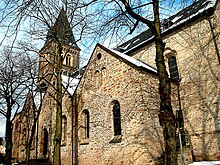Evangelical Church Herdecke
The Protestant collegiate church St. Marien is a listed church building in Herdecke in the North Rhine-Westphalian Ennepe-Ruhr district in Germany .
History and architecture
The church is the former collegiate church of Herdecke Abbey , which was later called the Free World Women's Abbey . The Rule of Benedict has been handed down since 1313. According to news from the 16th century, the monastery is said to have been founded in 810 or 819 by a Frederuna or Vrederuna, alleged relatives of Charlemagne . Modern research questions both the existence and origin of the founder, as well as this early monastery foundation. The monastery was first mentioned, albeit indirectly, in the years 1183/4 when a canoness from "Herrike" testified to miracles that were reported as part of the Anno worship. The oldest surviving document from the monastery itself dates from 1214. As of the 13th century, sources name some abbesses and canonesses from the regional nobility. In the second half of the 13th century, precarious economic and personal conditions are reported, from which the monastery recovered. In 1488 the Kloser was transferred to a free worldly women's monastery. In the 16th century the Protestant faith found its way into the monastery, since 1666 it was a simultaneous pen. At least since then, the economic and religious decline began. The women's monastery was finally dissolved in 1812.
The statement from older research literature that the main substance of a Carolingian complex from the 9th century would still be preserved in the existing building is still supported, even if the early founding date of the monastery is doubted. According to this, a stone church, which was huge for the time of the 9th century, must have been built without a monastery and without a bishopric. That would be a one-off event for Westphalia, especially since the church was not intended for the veneration of relics and a community should not have existed either; In any case, the principle of the parish church does not apply in the 9th century. The recent interpretations of the excavation findings and interpretations of the architecture also give no reason to date the church building to the 9th century. According to today's perspective, the excavation results from the years 1937–1939 do not allow for an exact date of the foundation construction. The Marian patronage and the lack of a crypt also speak against such an early foundation. In fact, if the founding of the monastery was still Franconian, especially by an alleged exponent of the ruling house, the takeover of a saint venerated in Franconia and the relics of his relics (in a crypt) should be expected. That would be typical and would have corresponded to the Carolingian religious-political program to consolidate the Christian faith in the conquered Saxon area.
The originally flat-roofed, three-aisled pillar basilica was built with transept arms and probably three parallel apses . It consists of very small Ruhr sandstone and has no decorative shapes or structural elements either inside or outside. A western closure must have been available; it is absent from drawings of the church from the 18th century. The construction of a western closure is therefore unknown, as is when and why it was removed. Perhaps a west block is to be expected, a "reduced westwork" or a west end consisting of a central tower and side annex buildings, such as in Haltern-Flaesheim. From around the 2nd quarter of the 13th century, a box choir replaced the former aspsidial closure.
In the second half of the 13th century , major structural changes were made: the transept arms and the apses were demolished and the naves vaulted. 1902–1903 the neo-Romanesque west tower was built in place of the west end that had probably not existed for centuries, the previous turret was broken off and the vaults in the west bays of the central nave and the aisles were redesigned.
Furnishing
- Numerous grave slabs from the 17th and 18th centuries
- Lead glass windows from 1958 and 1960 by Walter Benner
Bells
The old bronze bells were confiscated during World War I and replaced by three chilled cast iron bells in 1919. The big bell had to be replaced as early as 1926.
In 2004 the decrepit bells were replaced by five bronze bells from the Perner bell foundry in Passau . The bells are in detail: Maria (festival bell, tone d '), Anna (Sunday and death bell, tone f'), Johannes (prayer bell, tone b '), Martin (sacrament bell, tone c ") and Nikolaus (praise and Thank you bell, tone d ").
literature
- Georg Dehio : Handbook of the German art monuments . North Rhine-Westphalia . Volume 2: Westphalia. Deutscher Kunstverlag, Munich 2016, ISBN 978-3-422-03114-2 .
- Karl Hengst (Ed.): Westphalian monastery book. Part 3: Institution and Spirituality. Aschendorff Verlag, Münster 2003.
- Wilfried G. Vogt: Annonisches miracle work in Herdecke and Breckerfeld. Hagiographic sources in the local historical reception. (= Contributions to the history of Dortmund and the county of Mark ). Published by Günther Högl and Thomas Schilp on behalf of the Historical Association for Dortmund and the Grafschaft Mark eV 2009/10.
- Roland Pieper: Historical monasteries in Westphalia-Lippe. Ardey-Verlag, 2003, ISBN 3-87023-244-7 .
Web links
- LWL picture archive: drawings of the former Herdecke Abbey
- Entry on www.kirchbau.de
- Website of the Ev. Herdecke parish
- Indoor shot
Individual evidence
- ^ Georg Dehio , Dorothea Kluge, Wilfried Hansmann , Ernst Gall : Handbook of German Art Monuments. North Rhine-Westphalia . tape 2 : Westphalia . Deutscher Kunstverlag, Munich / Berlin 1969, OCLC 272521926 , p. 218 .
Coordinates: 51 ° 23 '59.2 " N , 7 ° 25' 54.8" E


